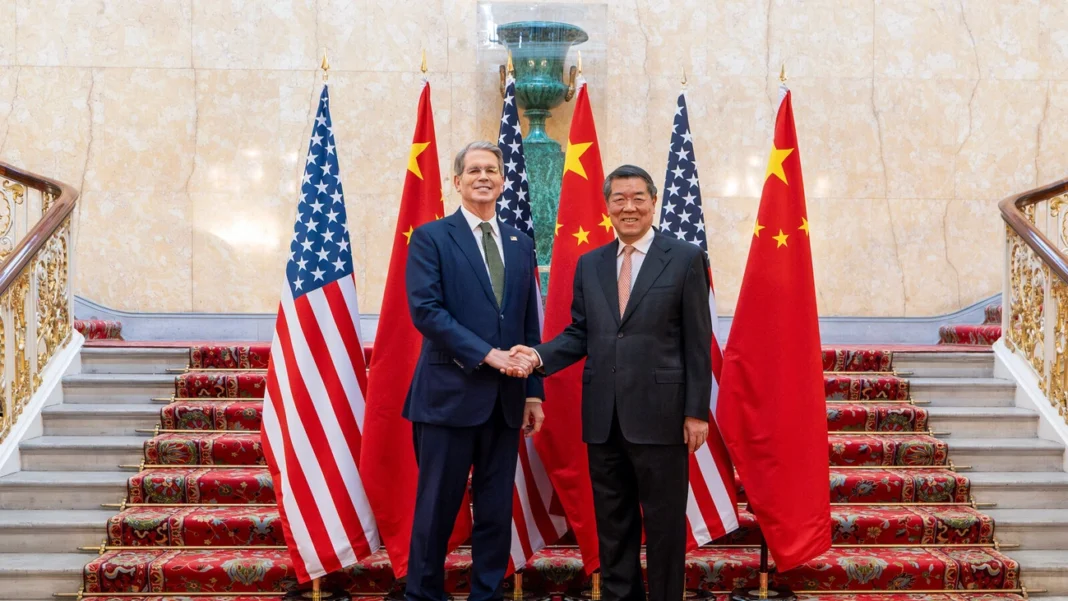Rare earth minerals have become a critical flashpoint in global trade relations as China controls approximately 90% of global rare earth processing, according to the International Energy Agency. After months of escalating tensions, the United States and China have reached a historic agreement to resume the flow of these essential materials, effectively ending a de-facto trade embargo that threatened supply chains worldwide. The two countries finalized this landmark deal last month in Geneva, signaling a potential thaw in one of the most contentious aspects of their economic relationship.
What are rare earth minerals exactly? Despite their name, these elements are relatively abundant in the Earth’s crust but typically difficult to extract and process. China dominates the global market, producing about 60% of these critical minerals and refining nearly 90%. Furthermore, these materials are essential components in numerous high-tech applications, including military equipment, which has heightened concerns about supply vulnerabilities. Car manufacturers, for instance, have already reported factories nearly halting operations because of supply chain shortages. The recent export controls apparently became a central issue in trade negotiations between Beijing and Washington after China imposed permit requirements on seven rare earth elements in April, highlighting their strategic importance in the ongoing economic competition between the world’s two largest economies.
US and China Sign Rare Earth Export Agreement
Image Source: The Lufkin Daily News
China’s Ministry of Commerce confirmed on Friday that officials from both nations have finalized details of a trade framework with the United States, marking a significant step toward easing tensions in the ongoing rare earth minerals dispute. The agreement specifies that China will “review and approve applications for the export of controlled items,” while the United States will “correspondingly cancel a series of restrictive measures it has taken against China”.
Commerce Secretary Howard Lutnick told Bloomberg News that the United States would “take down” export controls once China began delivering rare earth minerals. President Donald Trump announced the deal on Thursday, stating “we just signed with China the other day,” though he provided few specifics. Lutnick subsequently clarified that the agreement was “signed and sealed” two days earlier.
This landmark arrangement follows multiple rounds of high-level negotiations between the economic superpowers. Trade teams initially met in Geneva in May, subsequently holding talks in London on June 9-10. Following these meetings, negotiators “maintained close communication” to finalize the framework.
The agreement primarily addresses Beijing’s April restrictions on seven rare earth elements that threatened to disrupt production of cars, robots, wind turbines and other high-tech products globally. These export controls had become a central point of contention, subsequently eclipsing tariff issues in recent trade negotiations.
Although China’s statement did not explicitly mention rare earths, the Commerce Ministry announced earlier that Beijing was accelerating review of export license applications for these critical minerals and had approved “a certain number of compliant applications”. Additionally, reports indicate that Chinese rare-earth magnet producer JL MAG Rare-Earth obtained export licenses that included the United States.
Nevertheless, certain challenges remain unresolved. China has reportedly not committed to grant export clearance for some specialized rare-earth magnets needed specifically for U.S. military applications, including fighter jets and missile systems. Moreover, Chinese negotiators appeared to link progress in this area with U.S. curbs on advanced AI chips exports to China.
China Lifts Export Curbs Amid Trade Tensions
Image Source: The New York Times
Beijing imposed export restrictions on rare earth minerals on April 4, requiring companies to secure special licenses for seven critical elements: samarium, gadolinium, terbium, dysprosium, lutetium, scandium, and yttrium. This move came in direct response to President Trump’s sweeping tariff increases on Chinese products.
The licensing regime quickly disrupted global supply chains. Exporters faced a two-to-three-month wait for approvals, effectively halting shipments at Chinese ports. Consequently, manufacturers worldwide reported serious concerns about depleting stocks. Ford announced production cuts for its SUVs in Chicago, Suzuki reduced production of its Swift model in Europe, and the Alliance for Automotive Innovation warned that without reliable access to these elements, “automotive suppliers will be unable to produce critical automotive components”.
China controls approximately 99.8% of global production of heavy rare earths, making alternative sources virtually nonexistent. The shortage concerns stemmed not from lack of global supply—production has actually outpaced demand in recent years—but rather from China’s dominant position in processing capacity, accounting for 92% of refined production.
In recent weeks, China has gradually eased restrictions. The Commerce Ministry announced it would “fast-track” licenses for European companies and establish a “green channel” for eligible export applications. Notably, China granted temporary export licenses to suppliers of the top three US automakers and approved “a certain number of compliant applications”.
Yet challenges remain. Under the dual-use licensing regime, exporters must still seek approvals for each shipment and submit documentation verifying the intended end use. Industry sources report China has been “vetting buyers to ensure materials are not diverted to US military uses”, significantly slowing the licensing process. Analysts expect restrictions will continue prohibiting shipments to military suppliers, leaving US defense contractors without access to these critical materials.
The Commerce Ministry stated these export controls aim to “better safeguard national security and interests”, insisting the measures reflect China’s commitment to “world peace and regional stability”.
Rare Earths Remain a Strategic Battleground
Image Source: Reuters
The strategic value of rare earth minerals extends far beyond commercial applications, representing a crucial battleground in global power dynamics. These 17 elements play a vital role in national security, with military systems heavily dependent on their unique properties. Indeed, a US Virginia-class submarine requires about 9,200 pounds of rare earth materials, while an F-35 fighter jet contains over 900 pounds.
Even as diplomatic channels reopen, fundamental vulnerabilities persist. China’s near-monopoly over the entire supply chain remains largely intact, controlling almost 70% of extraction and 90% of processing globally. For certain heavy rare earths like dysprosium and terbium—critical for precision-guided weapons and advanced radar systems—China’s market share approaches 99%.
The Pentagon has recognized this dependency as a national security risk, investing over $439 million since 2020 to establish domestic supply chains. However, progress remains slow. MP Materials, operating America’s only active rare earth mine in Mountain Pass, California, produced just 1,300 tons of neodymium-praseodymium oxide in 2024—a fraction of China’s estimated 300,000 tons of magnet production that same year.
Other nations face similar challenges. The European Union lacks a single operational rare earth mine despite having sufficient resources. Japan, after experiencing China’s export ban in 2010 during a territorial dispute, has developed some processing capacity but remains dependent on Chinese raw materials.
The Department of Defense aims to develop a complete “mine-to-magnet” rare earth supply chain by 2027, yet analysts remain skeptical of meeting this timeline. USA Rare Earths only recently produced its first sample of dysprosium oxide in January 2025.
In essence, the recent diplomatic breakthrough does little to alter the underlying strategic calculus. As both nations compete in developing advanced military technologies like “sixth generation” fighter aircraft, access to these critical minerals will continue shaping the balance of global power.
Looking Ahead: Strategic Implications and Future Challenges
The historic US-China rare earth agreement undoubtedly marks a significant milestone in addressing immediate supply chain disruptions. Nevertheless, fundamental challenges persist beyond this diplomatic breakthrough. Both nations continue their strategic positioning in what essentially remains a critical minerals chess game with global implications.
China, despite easing export restrictions, maintains its dominant position throughout the rare earth supply chain. Additionally, the selective approach to licensing—particularly regarding military applications—highlights how these minerals function as powerful geopolitical leverage. Consequently, concerns about supply security will likely drive policy decisions for years to come.
The United States, meanwhile, faces a long road toward meaningful supply chain independence. Although investments in domestic production have increased significantly, American processing capacity remains woefully inadequate compared to Chinese capabilities. Furthermore, developing a complete “mine-to-magnet” infrastructure requires not just capital but considerable time and technical expertise.
This rare earth dispute clearly demonstrates how critical minerals have become central to modern economic and military competition. Subsequently, both countries will likely approach future negotiations with these strategic considerations at the forefront. Until now, no nation has successfully developed a comprehensive alternative to China’s rare earth ecosystem, leaving global manufacturers vulnerable to supply disruptions.
The automotive industry, particularly affected by recent shortages, must accordingly develop more resilient supply strategies. Similarly, defense contractors face ongoing uncertainty regarding access to specialized materials for military applications. Above all, this situation underscores how deeply intertwined the US and Chinese economies remain despite growing strategic competition.
Therefore, while this agreement provides welcome relief to manufacturers worldwide, it certainly does not resolve the underlying strategic tensions. Rather, it represents one chapter in what will likely be a continuing saga of competition over critical resources essential to technological leadership and national security in the 21st century.






